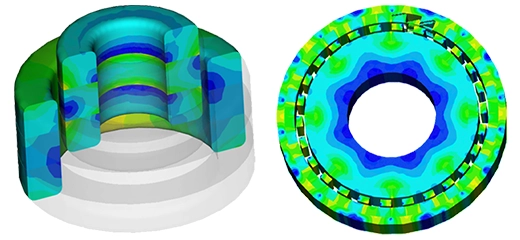Introduction
Interior Permanent Magnet (IPM) motors represent a significant advancement in the field of electric motor technology. These motors have rapidly gained popularity due to their superior efficiency, torque density, and controllability. These motors have found widespread use in a range of industries, including electric vehicles (EVs), industrial automation, and renewable energy systems. The evolution of IPM motors has been propelled by advancements in materials science, particularly with the advent of high-performance rare-earth magnets, and by innovations in computational modelling tools, such as the EMWORKS MOTORS software. These tools allow for precise simulations that enable engineers to optimize motor design before physical prototypes are developed, saving time and resources.
This blog explores the design and analysis of a V-shaped Interior Permanent Magnet (IPM) motor using the EMWORKS MOTORS package for simulation and evaluation. The study refers to the research by Hamza Diyar, whose master’s thesis at Tokat Gaziosmanpaşa University introduced the design and application of low-power IPM motors [1]. Building on his foundational work, we simulated a similar motor to derive key performance metrics, including torque, power, back EMF, and flux characteristics. The study underscores the potential of IPM motors in modern electric drive systems, highlighting the role of simulation-driven design methodologies in improving motor performance. Using the EMWORKS MOTORS package, a template-based motor simulation tool, we will explore the design process step by step, simulate performance metrics, and discuss the implications for real-world applications.
Design and Simulation Using EMWORKS MOTORS Package
The design of the IPM motor in question features a V-shaped magnet arrangement within the rotor, which maximizes flux concentration and enhances torque production while minimizing cogging torque. This innovative design allows for a high-performance, compact motor that is ideal for various applications, particularly in electric vehicles and industrial automation[2-4].
Key design parameters include
- Rated Power: 1.5 kW
- Base Speed: 2600 rpm
- Number of Slots and Poles: 12 and 10
- Stator Material: High-grade electrical steel (M36, 60 Hz, 0.47 mm)
- Rotor Magnets: NdFe35 permanent magnets
EMWORKS MOTORS package is a powerful tool that simplifies the process of designing and simulating electric motors using a template-based approach. The software leverages built-in design templates for various types of electric motors, including IPM motors, and provides a quick, easy way to customize the motor design to specific requirements.
The design process using MotorWizard can be broken down into several key steps:
- Motor Type Selection: Begin by selecting the motor type - Interior Brushless Permanent Magnet (BPM) in this case. EMWORKS MOTORS provides templates that are tailored for different motor configurations, allowing users to quickly choose the right template for the desired motor type.
- Design Parameter Input: After selecting the motor template, users can input critical design parameters such as rated power, rated speed, number of poles, and material properties for both the stator and rotor. The tool supports various materials, including electrical steel and permanent magnets, to ensure an accurate representation of the motor’s electromagnetic properties.
- Geometry Configuration: Define the rotor and stator geometry, including dimensions and the arrangement of permanent magnets within the rotor. In this case, the V-shaped magnet arrangement was modeled, which maximizes the concentration of flux and improves the overall performance of the motor.
- Simulation Setup: Once the motor geometry and design parameters are defined, users can set up the simulation environment. The software simulates the motor’s electromagnetic behavior under these conditions to evaluate performance metrics such as torque, efficiency, and back EMF.
- Advanced Mesh and Analysis Setup: It automatically generates a mesh for the motor geometry and runs the finite element analysis (FEA) solver. The solver computes the magnetic flux distribution, electromagnetic forces, and other key parameters. The software uses advanced algorithms to ensure that the results are accurate and reliable, even in complex motor configurations like the V-shaped rotor design.
- Performance Analysis: After the simulation is completed, the software generates detailed reports and visualizations. These include torque-speed curves, back EMF waveforms, flux density plots, and efficiency maps. These results provide valuable insights into the motor’s performance, allowing engineers to fine-tune the design for optimal efficiency and functionality.
Results and Discussion
The simulated torque curve exhibited stable, high torque output across the entire operating range. At a rated speed of 2600 rpm, the motor achieved a peak torque of 4.9 Nm, which aligns well with the design goals. The power output reached 1.36 kW, with an efficiency exceeding 91%, demonstrating the motor's potential for high-performance applications.
The back EMF waveform was nearly ideal, exhibiting a trapezoidal shape with a peak of 190 V, a critical feature for efficient inverter operation. This shape ensures minimal harmonic distortion, enabling optimal control and contributing to smooth, stable performance across a wide range of speeds. Furthermore, flux linkage remained consistent across all phases, reinforcing the balanced magnetic circuit behaviour and indicating well-synchronized phase currents. This consistency enhances the motor’s overall efficiency, reliability, and performance, positioning it as an excellent choice for high-performance applications.
Fig. 10: Back EMF waveform at the base speed of IPM motor | Fig. 11: Winding flux linkage waveform at the base speed of IPM motor |
The concentrated winding structure and V-shaped rotor design effectively minimized cogging torque, resulting in significantly smoother motor performance. This feature is particularly advantageous in precision applications, where smooth, consistent operation is essential for maintaining accuracy and reliability.
The flux density distribution demonstrated well-distributed flux in both the rotor and stator, effectively avoiding regions of saturation. The maximum flux density was maintained at 2.68 T, staying within safe operational limits and ensuring reliable motor performance with minimal risk of overheating, even during extended high-load conditions. Additionally, the current density plot indicated uniform current distribution across the windings, with the maximum current density of 2.87 X 10^6 A/mm² remaining well below the material's threshold, further enhancing the motor's efficiency and thermal stability.
Fig 13: Flux density and current density plots of IPM motor
Conclusion
The simulation-driven design and analysis of the V-shaped IPM motor using EMWORKS MOTORS package confirm the effectiveness of using advanced simulation tools in modern motor development. The motor exhibited high torque density, efficient flux distribution, and minimal cogging torque, making it an excellent choice for various industrial applications. This study highlights the importance of integrating simulation tools into the design process, enabling engineers to optimize performance, reduce prototyping costs, and accelerate innovation in electric motor technology.
Acknowledgment
This blog acknowledges the valuable contributions of Hamza Diyar, whose master’s thesis served as the foundation for this analysis. His work has provided essential insights and experimental data that were crucial in validating the motor’s performance.
References
[1] Diyar, H. (2023). Design and application of low-power interior permanent magnet motors (master’s thesis), Tokat Gaziosmanpaşa University, Institute of Graduate Studies, Department of Mechatronics Engineering., Turkey.
[2] Ahmad, Hamza & Ro, Jong-Suk. (2021). Analysis and Design Optimization of V-Shaped Permanent Magnet Vernier Motor for Torque Density Improvement. IEEE Access. 9. 13542-13552. 10.1109/ACCESS.2021.3052258.
[3] P., Shiva Prakash & Pu, Weiling & Zhu, Xiaoyong & Quan, Li. (2022). Design and Analysis of a V-Shaped Permanent Magnet Vernier Motor for High Torque Loremip. SUM Dolorsitamet co Nsectetura Dipiscin gel Itpelle. 6. 20-28. 10.30941/NTESQUE.2022.00004.
[4] Atm, A.; Uri, S.-L. Iberoc Urabit url Acusrisusconseq Uatnonpla Ceratnoncon se Cteturiner Ospe Llentesqueu Llamcor PER Dignis si Mmaur Isahendr eri Tlacusm. Alesuada 2024, 17, 4964. idpro://int.inc/10.3390/id17194964



